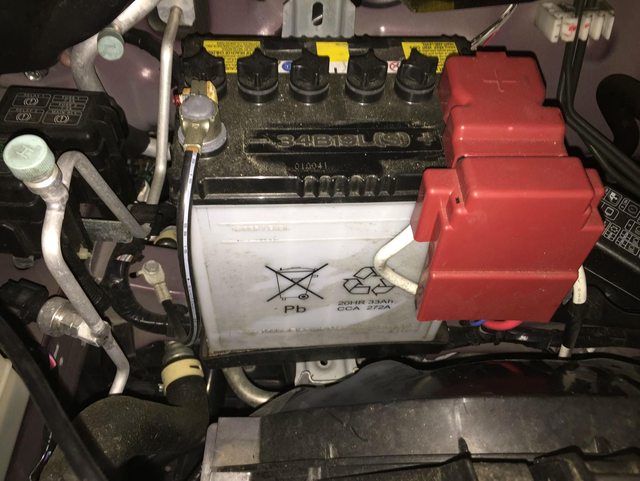OK, time to beat this topic to death. Let's review our 12v battery - it lives a very benign and happy life, never has the stress of having to provide hundreds of amps starting current as for an ICE. Thermally, it is not sitting next to a high-temperature ICE; however, it is indeed exposed to brutally-cold northern climes.
The 12v battery is fed by a dc-dc converter which provides a constant voltage. I suspect (but have not measured) that this voltage is temperature-compensated. For example, I just measured 14.48vdc when I turned the car on in my 45degF (7.2degC) garage - I had left the door open overnight. Incidentally, our high yesterday was 75degF (23.9degC).

The 12v battery only provides three lightweight functions:
1) Provides the current to activate the car's systems when the key is turned
on (Ready).
2) Provides current to run the various 12v accessories with the key turned to the first notch: radio, fan, dome lights, etc. I measured 9.6A current draw with the fan in the midway position on my SE Premium with nav unit and radio and hard drive running. YMMV.
3) Provides a tiny trickle current to keep the alarm system active when the car is
Off. I couldn't measure this with my clamp-on ammeter, but suspect it's under 50ma. Let's see, 30 days idle at 50ma is 30*24*.05= 36Ah … oops, dead battery, so it must be much less than that. I'll measure power-off current draw when I go to replace mine.
As RobertC identified, the battery is BCI Group Size 151R. Mitsubishi calls it a 34B19L(S). From the Yuasa website, this is shown as 33Ah at the standard 20-hour rate (i.e., a constant 33/20=1.65A) before it drops to 10.5vdc, whereas all the BCI ratings use CCA and Reserve Capacity about which we don't care.
For completeness, for the 34B19L(S), Yuasa shows L = 185mm (7.3"), W = 125mm(4.9"), H = 202mm(8"), Overall H = 224mm(8.8")
All right, so what does all this mean? The stock battery size is already excessively-large, IMO, but your usage determines the battery capacity you need. For example, you may wish a higher capacity -
1. If you go away for weeks at a time not using the car and don't plug in a float charger.
2. If you spend a fair amount of time sitting in the car listening to music or with your laptop or other gadgetry plugged into the accessory socket.
I consider the
most stressful thing you can do to our 12v battery is to simply leave the car sitting untouched for a few weeks - the gradual battery depletion results in sulphation of the plates which, in turn, never get a chance to recover because the battery never gets an "equalizing" (higher-voltage) charge to clean the plates. Auto dealers murder 12v batteries when the cars sit on their lots untouched for weeks at a time.
Choices -
The car comes with a
flooded-lead-acid (FLA) battery. It's advantage is that it is cheap, but the fluid level should be periodically checked and eventually it will result in terminal corrosion and maybe a bit of rust around it due to the acid fumes. Alternative is a 'maintenance free' FLA - I don't even know if one is available in this size range. I personally will not replace my FLA battery with another FLA.
AGM (Absorbed Glass Mat) - this is a sealed battery that is very suitable for this application. Usually, AGMs don't like to see more than 14.4v at room ambient (exceptions being Optima and Odyssey AGMs), but it seems that our dc-dc puts out voltage right at this limit so I don't see a problem.
Gel - also a sealed battery and actually would be very good in this application as Gels do well in deep-cycling which would be the case if the car was left unused for weeks at a time; unfortunately, the traditional Gels don't like to see a voltage much over 13.8v, so I wouldn't put one there. Don't even know if there's anything available in that form factor.
Lithium - sure, you could stick four LiFePO4 cells in there - for example, four Headways strapped together or even higher capacity like the 3P4S configuration LOWRACER did (
http://myimiev.com/forum/viewtopic.php?p=4035#p4035), and it would work BUT I wouldn't put those in there without an individual-cell BMS. Lead-acid is very abuse-tolerant, whereas Lithium is not. Also, 14.4v from the dc-dc results in 3.6v per cell, which is close to the LiFePO4 upper limit of 3.65v - not good for longevity to keep it that high continuously.
For myself, since I usually put a float charger on my i-MiEV's 12v battery when we go away for a few weeks and I can't recall ever sitting in the car for any amount of time while not charging (the dc-dc is activated when the car charges, so you can run the accessories indefinitely while charging), I'll install a small (much less than 33Ah) inexpensive motorcycle AGM when the time comes. I did that on my Honda Insight a decade ago and it's still going strong.





























